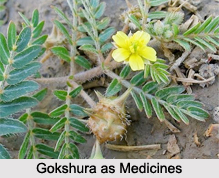 Gokshura in Ayurveda is an ancient herb, used since thousands of years for its immense medicinal qualities. Its botanical name is Tribulus terrestris. It is a plant from Ayurveda where the root and fruits are used for male virility and general vitality, respectively. The roots enhance libido and sexual well being without affecting testosterone while the fruits appear to be potently protective of organ function.
Gokshura in Ayurveda is an ancient herb, used since thousands of years for its immense medicinal qualities. Its botanical name is Tribulus terrestris. It is a plant from Ayurveda where the root and fruits are used for male virility and general vitality, respectively. The roots enhance libido and sexual well being without affecting testosterone while the fruits appear to be potently protective of organ function.
This plant is also called Sthala sringataka and Trikantaka, from the resemblance of its fruits to those of Trapa bispinosa and from their being armed with 3 spines. The entire plant but more particularly the fruits are used in medicine. They are regarded as cooling, diuretic, tonic and aphrodisiac and are used in painful micturition, calculous affections, urinary disorders and impotence. The fruits constitute an ingredient of Dasamula.
Dose of Gokshura in Medicine
A decoction of the fruits is given with the addition of yavakshara (impure carbonate of potash), in painful micturition. A decoction of the entire plant is given with silajatu (a bituminous substance) and honey, in the same affection. Equal parts of gokhuru and sesamum seeds, taken with goat"s milk and honey, is said to cure impotence arising from bad practices.
Processing of Gokshurdaya Valeha
Gokshurdaya valeha or electuary of gokshuri is prepared as follows: Take of the entire plant of Tribulus terrestris, 12 seers and a half, water 64 seers and boil till reduced to one-fourth. To the strained decoction, add 6 seers and a quarter of sugar and again boil till reduced to the proper consistence for an electuary; then add the following substances in fine powder, namely, ginger, long pepper, black pepper, cinnamon, cardamoms, flowers of Mesua ferrea (nagakesara), leaves called tejapatra, nutmeg, bark of Terminalia Arjuna and cucumber seeds, each 16 tolas, bamboo-manna half a seer, and prepare an electuary. It is given in doses of 2 tolas, in painful micturition, suppression of urine, bloody urine, calculous affections etc.
This article is a stub. You can enrich by adding more information to it. Send your Write Up to content@indianetzone.com
Related Articles
Ayurveda
Origin of Ayurveda
Ayurveda Medication
Elements of Ayurveda
Concepts of Ayurveda
Ancient Literature of Ayurveda




















